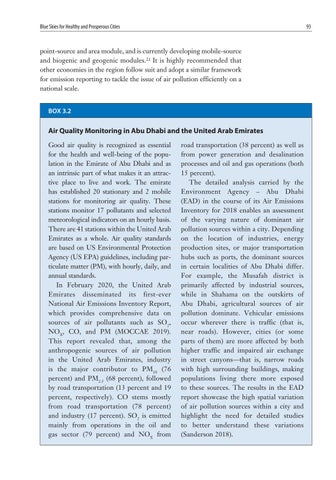Blue Skies for Healthy and Prosperous Cities
93
point-source and area module, and is currently developing mobile-source and biogenic and geogenic modules.21 It is highly recommended that other economies in the region follow suit and adopt a similar framework for emission reporting to tackle the issue of air pollution efficiently on a national scale. BOX 3.2
Air Quality Monitoring in Abu Dhabi and the United Arab Emirates Good air quality is recognized as essential for the health and well-being of the population in the Emirate of Abu Dhabi and as an intrinsic part of what makes it an attractive place to live and work. The emirate has established 20 stationary and 2 mobile stations for monitoring air quality. These stations monitor 17 pollutants and selected meteorological indicators on an hourly basis. There are 41 stations within the United Arab Emirates as a whole. Air quality standards are based on US Environmental Protection Agency (US EPA) guidelines, including particulate matter (PM), with hourly, daily, and annual standards. In February 2020, the United Arab Emirates disseminated its first-ever National Air Emissions Inventory Report, which provides comprehensive data on sources of air pollutants such as SO2, NOX, CO, and PM (MOCCAE 2019). This report revealed that, among the anthropogenic sources of air pollution in the United Arab Emirates, industry is the major contributor to PM10 (76 percent) and PM2.5 (68 percent), followed by road transportation (13 percent and 19 percent, respectively). CO stems mostly from road transportation (78 percent) and industry (17 percent). SO2 is emitted mainly from operations in the oil and gas sector (79 percent) and NOX from
road transportation (38 percent) as well as from power generation and desalination processes and oil and gas operations (both 15 percent). The detailed analysis carried by the Environment Agency – Abu Dhabi (EAD) in the course of its Air Emissions Inventory for 2018 enables an assessment of the varying nature of dominant air pollution sources within a city. Depending on the location of industries, energy production sites, or major transportation hubs such as ports, the dominant sources in certain localities of Abu Dhabi differ. For example, the Musafah district is primarily affected by industrial sources, while in Shahama on the outskirts of Abu Dhabi, agricultural sources of air pollution dominate. Vehicular emissions occur wherever there is traffic (that is, near roads). However, cities (or some parts of them) are more affected by both higher traffic and impaired air exchange in street canyons—that is, narrow roads with high surrounding buildings, making populations living there more exposed to these sources. The results in the EAD report showcase the high spatial variation of air pollution sources within a city and highlight the need for detailed studies to better understand these variations (Sanderson 2018).






